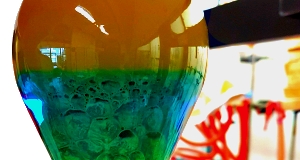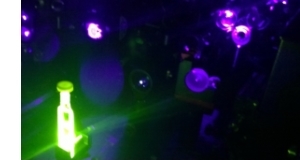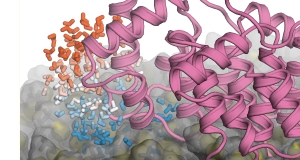
The majority of chemical reactions, including many that are central to important industrial and virtually all biological processes, take place in a liquid-state environment. Solvents – with water being the most prominent – are used to “solvate” molecular species ranging from industrial reagents to biological molecules in living cells. Solvents also “wet” surfaces such as lipid membranes or metal electrodes, thus creating new interfaces. Understanding “Solvation” is not only relevant to these issues, but will stimulate major advances in emerging key technologies, such as green chemistry and electrochemistry. It is essential for optimizing industrial processes, avoiding environmental hazards, preventing corrosion, or increasing energy efficiency, to list a few key challenges relevant to society. In the life sciences, water is the ubiquitous solvent, sometimes even called the “matrix of life”; understanding its function is crucial for comprehensively unraveling key biological functions.
The scientific strategy of the Research Department “Solvation Science” is vastly different from the traditional, empirical, macroscopic, and descriptive approach, which is often followed. We are instead working on a unifying, bottom-up framework, being as universal and comprehensive as possible. The aim is the development of predictive Solvation Science based on a molecular rational-design perspective. Within this framework, solvent molecules are regarded to contribute to function themselves and employed as active species or reactive agents in solvent-mediated and solvent-controlled processes, respectively, rather than only being considered as inert and passive bystanders.
We are intimately coupling the most sophisticated state-of-the-art experimental, spectroscopic, and synthetic approaches with the most recent advances in computer simulation to tackle the important scientific challenges. Understanding solvation phenomena on this molecular level will most directly impact a wide range of applications, such as pitting corrosion of steel, biosensor development, biomass conversion for platform chemicals, microcapsules for drug release, fluid extraction/purification processes, high-tech batteries, “green” asymmetric organocatalysis, and low-energy brine electrolysis.
Based on these general scientific strategies, we have identified three Core Directions from which the collaborating research groups at the RUB can tackle pressing scientific questions focusing on Solvation:

Core Direction Synthesis & Catalysis
Most chemical transformations are performed either in solution or at the interface between a liquid and solid or soft materials. Even though it is known that the success of a reaction often crucially depends on the choice of the appropriate solvent, there is still a significant lack of understanding of the actual role of the solvent at the molecular level. Thus, we aim to study in detail the fundamental role of solvents and solvent systems in synthetic transformations and in catalysis.
Broad expertise is available at RUB in several key areas of catalysis. This includes the investigation of transformations involving metal catalysts and organocatalysts, reactions at liquid/solid and liquid/soft matter interfaces, and electrochemical systems. We aim to develop a molecular model of the interplay of solvent and reactants in all these cases, which will provide a powerful basis for the rational optimization of these processes. These investigations are not restricted to the classical solvents, but will be extended towards the development of novel/unconventional solvent systems, which will allow the exploration of more efficient reaction paths. A specific advantage of our broad approach to this topic is the fact that synergistic effects will be utilized by combining methods and findings from different areas of research. In addition, close cooperation with experts in spectroscopy and theory at RUB will ensure that our view of solvation will not remain at the currently rather macroscopic level, but will rather include specific molecular effects and interactions that will build up a comprehensive model. In the long term, we hope to provide powerful tools for the sensible development of exciting new synthetic transformations.

Core Direction Spectroscopy & Analysis
Solvation not only changes the properties of reactants and products, but also affects transition states and equilibria. Solvents thus influence the thermodynamics, the kinetics, efficiencies, and the product selectivity in liquid phase reactions, aspects whose identification are of vital importance both for fundamental research and industrial applications. Also in most biomolecular and cellular processes, the aqueous environment plays a key role for driving biomolecular processes. Within the Research Department, we will connect solvation dynamics with biomolecular function and thereby pave the way to achieve a detailed understanding of the structure-dynamics-function relationships of proteins, up to protein (mis-)folding and formation of amyloid fibrils. Obtaining an improved comprehension of solvent impact on catalytic, electrochemical, and photoinduced processes will open new directions for rational drug design and many applications involving liquid-phase chemistry.
For an in-depth understanding of these solvation effects, the underlying processes and associated mechanisms have to be disclosed by means of detailed, sophisticated analysis. At the RUB, the researchers can rely on a remarkable technology pool and substantial expertise comprising calorimetry, electrochemistry, microscopy, surface science, and various spectroscopic approaches. Collaborative projects on RUB campus will shed light on the different facets of solvation processes with complementing experimental tools and research methods. Besides an exploration of solvation phenomena with state-of-the-art apparatuses, a further aspect will be to push the technological limits and develop novel experimental approaches which allow unprecedented views on solvation. This strategy is realized in two ways: on the one hand, advanced methods in, e.g., electrochemistry or laser spectroscopy will be further improved; on the other hand, emphasis is put on the design and construction of analytic tools which are unavailable up to now. The latter efforts will build on the cross-faculty cooperation in THz laser research, since reliable light sources in the THz regime are highly beneficial for solvation studies.

Core Direction Theory & Simulation
To achieve the desired unifying, bottom-up framework and to establish predictive Solvation Science from a molecular rational-design perspective, a detailed, atomic-level understanding of the underlying phenomena is required. Although tremendous progress has been made with a number of experimental techniques, it remains highly challenging for experiments to realize the spatial and temporal resolution necessary for obtaining such detailed insights. State-of-the-art computer simulations can provide these missing insights. Due to methodological advancements and increasing computational power, today’s Theoretical Chemistry approaches can now be used as a “Virtual Lab” to generate detailed insights into the mechanisms of solvent-driven chemical transformations under various conditions, closely mimicking the experimental set-ups.
The Theoretical Chemists at RUB involved in the Research Department share the common belief that greatest progress can be achieved by combining theory with experiments in a synergistic manner, as such a close combination enables to gain unprecedented insights that cannot be achieved by any method alone. Efforts are concentrated on understanding solvent-driven biomolecular processes, reactions at liquid/solid and liquid/soft matter interfaces (incl., but not limited to, catalysis), and chemical reactions in classical as well as unconventional solvents, to name just a few.


